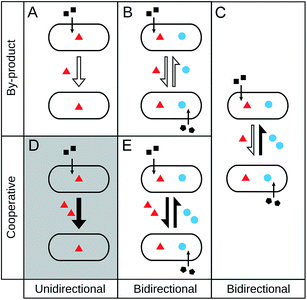Chapter 12 Basics of Symbiotic Interactions
Content taken from Dr. Roxanne Beinart’s class OCG594. Papers and figures cited from research/review papers we focused on this semester.
Ecological Interactions = biological interactions b/w and among organisms; doesn’t necessarily require contact.
- Inter-specific: co-actions
- Intra-specific: Intra-actions
Mechanisms of interaction and/or metabolite transfer; contact-independent based on the diffusion through extracellular environment (D’Souza et al., 2018).

Interactions defined by effect on participants: 1.) individual level: reproductive performance, changes of survival, weight change, health 2.) population level: persistance, reproductive productivity, average condition of individuals, average density (biomass). Individual effect do not always = population effects.
There are also indirect effects: organisms exist in interaction networks (i.e. 3+ taxa). An interaction between two organisms may have an impact on another not directly involved.
Defining cost/benefit = net cost/benefit: does intxn increase, decrease, or not change the fitness/reproductive success of partners?
Types of symbiosis:
1. Cooperation +/+ (mutualism = obligate, protocooperation = not obligate)
2. Commensalism +/0
3. Exploitation +/- (predation, parasitism, altruism)
4. Amensalism 0/- (i.e. waste product of one organism toxic for another)
5. Competition -/- (active vs. passive)
Cooperation
Types of cross-feeding = forms of cooperation (D’Souza et al., 2018). Blank arrows = by-product release; black arrows = costly metabolite. This can be classified in terms of degree of reciprocity. Cooperative is the bottom panel.

Corals would fall into E or C: bidirectional.. come back to bi-product vs. costly metabolite.
Commensalism
In the above figure, commensalism = panel A.
i.e. microbes attached to surfaces of larger organisms.
Exploitation
Parasitism = sustained over time (parasite = might not kill partner; parisitoid = kills partner)
Predation = short duration, kills partner
Altruism = intra-specific intxn; release of metabolically expensive metabolite that benefits others of same spp but not individual (i.e. programmed cell death release nutrients, takes damaged cell out of population and leaves nutrients for others)
Competition
Resource (exploitative) competition: both organisms competing for same resource
Interference competition (antagonism): organisms exert direct, negative effects on one another
In reality, this is all happening at the same time in a network:
Beinart, class slides:

Interaction ‘barcode’ = list of variables/attributes that describe the interaction (Pacheco and Segre 2019).